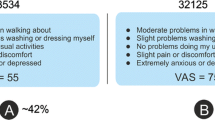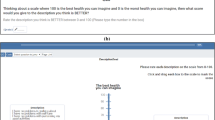Abstract
Background:
Conditions were studied that may invalidate health-state values derived from the visual analogue scale (VAS).
Methods:
Respondents were asked to place cards with descriptions of EQ-5D health states on a 20 cm EuroQol VAS and modified versions of it, positioning them such that the distances between the states reflect their valuation for these states. Anchor-point bias was examined using the standard EuroQol VAS (n = 212) and a modified version (n = 97) with a different lower anchor. Context bias was examined in another group of respondents (n = 112) who valued three different sets of EQ-5D health states. Marker bias was studied in yet another group of respondents (n = 100) who placed the same EQ-5D states on the standard EuroQol VAS and on a modified VAS without anchors, categories, or measurement markers.
Results:
No indication for the existence of the anchor-point and the marker bias was found. However, the VAS valuations were significantly affected by the context of the set of health states in the scaling task.
Conclusion:
Advanced methodologies should be incorporated in VAS valuation studies to deal with the context bias.
Similar content being viewed by others
References
Smith A. (1987). Qualms about QALYs. Lancet 329:1134–1136
Froberg DG, Kane RL (1989). Methodology for measuring health-state preferences – II: Scaling methods. J Clin Epidemiol 42:459–471
Nord E. (1992). Methods for quality adjustment of life years. Soc Sci Med 34:559–569
Hayes MHS Patterson DG (1921). Experimental development of the graphic rating method. Psycholog Bull 18:98–99
Aitken RCB. (1969). Measurement of feelings using visual analogue scales. Proc Roy Soc Med 62:989–993
Zealley AK, Aitken RCB. (1969). Measurement of mood. Proc Roy Soc Med 62:993–996
Priestman TJ, Baum M. (1976). Evaluation of quality of life in patients receiving treatment for advanced cancer. Lancet 1:899–900
Patrick DL, Bush JW, Chen MM. (1973) Toward an operational definition of health. J Health Soc Behav 14:6–23
McCormack HM, Horne DJ de J, Sheather S. (1998). Clinical applications of visual analogue scales: A critical review. Psycholog Med 18:1007–1019
Wevers ME, Lowe NK. (1990). A critical review of visual analogue scales in the measurement of clinical phenomena. Res Nurs Health 13:227–236
Parducci A. (1968). The relativism of absolute judgments. Sci Am 219:84–90
Thurstone LL. (1927) A law of comparative judgments. Psycholog Rev 34:273–286
Luce RD (1959). Individual Choice Behavior: A Theoretical Analysis. Wiley, NewYork
McFadden D. (1974). Conditional logit analysis of qualitative choice behavior. In: Zarembka P. (eds), Frontiers in Econometrics. Academic Press, New York
Dyer JS, Sarin RK. (1979). Measurable multi-attribute value functions. Oper Res 27:810–822
Krantz DH, Luce RD, Suppes P, Tversky A. (1971). Foundations of Measurement. Vol. 1: Additive and Polynomial Representations. Academic Press, New York
Keeney RL, Raiffa H. (1976). Decision with Multiple Objectives: Preferences and Value Trade-Offs. John Wiley, New York
Parkin D, Devlin N. Is there a case for using visual analogue scale valuations in cost-utility analysis? Health Econ 2006; 15: 653–664
Nunnally JC, Bernstein IH (1994). Psychometric Theory. McGraw-Hill, New York
Krabbe PFM, Essink-Bot ML, Bonsel GJ. (1997) The comparability and reliability of five health-state valuation methods. Soc Sci Med 45:1641–1652
Krabbe PFM (2006). Revealing valuation structures of health states with singular value decomposition. Med Decis Making 26:30–37
Dolan P. (1997). Modeling valuations for EuroQol health states. Med Care 35:1095–1108
Lamers LM, McDonnell J, Stalmeier PF, Krabbe PF, Busschbach JJ. The Dutch tariff: results and arguments for an effective design of national EQ-5D valuation studies. Health Econ (on line).
Gudex C. Time trade-off user manual: Props and self-completion methods. Report of the Centre for Health Economics, University of York, 1994.
Raat H, Bonsel GJ, Hoogeveen CW, Essink-Bot M-L, and the Dutch HUI Group. Feasibility and reliability of a mailed questionnaire to obtain visual analogue scale valuations for health states defined by the Health Utilities Index Mark 3. Med Care 2004; 42: 13–18.
Brooks R, Rabin R, Charro de F. (2003). The Measurement and Valuation of Health Status Using EQ5D: A European Perspective. Kluwer Academic Publishers, Dordrecht
Torgerson WS. (1958) Theory and Methods of Scaling. Wiley, New York
Lamers LM, Stalmeier PFM, Krabbe PFM, Busschbach van JJ. (2006). Inconsistencies in TTO and VAS values for EQ-5D health states. Med Decis Making 26:173–181
Krabbe P, Charro de F, Essink-Bot M-L. (2005). Issues in the harmonisation of valuation and modeling. In: Kind P, Brooks R, Rosalind R (eds). EQ-5D Concepts and Methods: A Developmental History. Springer, Dordrecht
Bleichrodt H, Johannesson M. (1997). An experimental test of a theoretical foundation for rating-scale valuations. Med Decis Making 17:208–216
Kaplan RM, Ernst JA. (1983). Do category rating scales produce biased preference weights for a health index? Med Care 21:193–207
Robinson A, Loomes G, Jones-Lee M. (2001). Visual analog scales, standard gambles, and relative risk aversion. Med Decis Making 21:17–27
Parducci A, Wedell DH. (1986). The category effect with rating scales: number of categories, number of stimuli, and method of presentation. J Exp Psychol, Human Percept Perform 12:496–516
Torrance GW, Feeny DH, Furlong WJ. (2001). Visual analog scales: do they have a role in the measurement of preferences for health states? Med Decis Making 21:329–334
Essink-Bot M-L, Stouthard MEA, Bonsel GJ. (1993) Generalizability of valuations on health states collected with the EuroQol-questionnaire. Health Econ 2:237–246
Anderson NH. (1976). How functional measurement can yield validated interval scales of mental quantities. J Appl Psychol 61: 677–692
Stevens SS. (1957). On the psychological law. Psycholog Rev 64:153–181
Hand DJ, (2004) Measurement Theory and Practice: The World Through Quantification. Arnold, London
Salomon JA, Murray, CJL. (2004). A multi-method approach to measuring health-state valuations. Health Econ 13:281–290
Acknowledgments
We would like to thank Arto Ohinmaa and Jeffrey Johnson for the constructive comments they made during the 21st Plenary EuroQol Group Meeting, Chicago, 16–18 October 2004. This research was made possible by a grant from the ZonMw National Research Council (945-10-033/047) and a supplementary grant from the EuroQol Group. Respondents were recruited by the Global Data Contact Centre (Rotterdam).
Author information
Authors and Affiliations
Corresponding author
Rights and permissions
About this article
Cite this article
Krabbe, P., Stalmeier, P., Lamers, L. et al. Testing the interval-level measurement property of multi-item visual analogue scales. Qual Life Res 15, 1651–1661 (2006). https://doi.org/10.1007/s11136-006-0027-7
Accepted:
Published:
Issue Date:
DOI: https://doi.org/10.1007/s11136-006-0027-7




